Mountain Flood Risk: A Bibliometric Exploration Across Three Decades
Abstract
1. Introduction
- Elucidating research trends and drivers–by examining annual publication output over a 30-year period, this study delineates the evolution of global research activity, emphasizes its scientific importance, and analyzes the underlying factors driving these developments.
- Examining collaboration networks and academic contributions—this study maps the spatial distribution of leading contributing countries and institutional networks while analyzing patterns of international collaboration and their temporal evolution; it further elucidates national academic contributions and the topological framework of transnational cooperation, assessing the strength, influence, and scope of international and interdisciplinary collaborations among research institutions.
- Characterizing research hotspots and frontiers—employing keyword co-occurrence and clustering analyses, this study traces the dynamic evolution of research themes; identifies core domains, current hotspots, and emerging frontiers; and delineates underexplored areas.
2. Materials and Methods
2.1. Data Acquisition and Retrieval Methodology
2.2. Empirical Data Assessment
3. Results
3.1. Research Publications and Patterns
3.2. Global Insights and Institutional Patterns
3.2.1. Key Country Perspectives
3.2.2. Key Institutional Analysis
3.3. Temporal Dynamics and Impact of Keywords
3.3.1. Keyword Clustering Analysis
3.3.2. Temporal Evolution of Keywords
- Extract keywords and publication years from literature databases to form a time-series dataset;
- Compute co-occurrence strengths (e.g., cosine similarity or association strength) to build a weighted network, and then optimize the community structure via modularity (Q-value) and pruning methods (e.g., Pathfinder);
- Use time-zone views to segment research phases, identify high-frequency keywords and their burst intensities, and assess influence via normalized citation rates;
- Generate cluster labels and timelines to reveal how thematic focuses disperse and evolve.
- -
- 1995–2001—“flash flood” (526 occurrences, 27.31%), “model” (312, 16.20%), and “risk assessment” (197, 10.23%) dominated, reflecting foundational work on flood characterization and modeling;
- -
- 2002–2011—“risk” (188, 13.48%), “rainfall” (150, 10.75%), and “debris flow” (82, 5.88%) showed strong bursts (strengths 13.48, 10.75, and 5.88), marking a shift toward evaluating risk and secondary hazards;
- -
- 2012–2024—“impact” (169, 13.90%), “vulnerability” (105, 8.63%), and “machine learning” (37, 3.04%) emerged with notable burst strengths (13.90, 8.63, and 3.04), indicating a shift toward studying socio-economic consequences and applying advanced analytical methods.
3.3.3. Keywords Exhibiting Peak Citation Surges
4. Discussion
4.1. Analysis of Global Trends and Dynamics
4.1.1. Growth Pattern Analysis
4.1.2. Statistical Comparative Analysis
4.1.3. Speculation on Influencing Factors
4.2. Analysis of Geographical and Institutional Drivers
4.2.1. National Influence and Research Impact
4.2.2. National Research Priorities
4.2.3. Analysis of the Research Structure
- Collaboration Network Density and Strength
- 2.
- Research Output and Academic Impact
- 3.
- International and Interdisciplinary Collaboration
4.3. Analysis of Core Themes and Evolutionary Dynamics
4.3.1. Thematic Distribution and Technological Frontiers
4.3.2. Thematic Evolution and Driving Forces
4.3.3. Dynamic Shift in Research Priorities
5. Conclusions
Author Contributions
Funding
Data Availability Statement
Conflicts of Interest
References
- Subraelu, P.; Ahmed, A.; Ebraheem, A.A.; Sherif, M.; Mirza, S.B.; Ridouane, F.L.; Sefelnasr, A. Risk Assessment and Mapping of Flash Flood Vulnerable Zones in Arid Region, Fujairah City, UAE-Using Remote Sensing and GIS-Based Analysis. Water 2023, 15, 30. [Google Scholar] [CrossRef]
- Li, W.J.; Lin, K.R.; Zhao, T.T.G.; Lan, T.; Chen, X.H.; Du, H.W.; Chen, H.Y. Risk assessment and sensitivity analysis of flash floods in ungauged basins using coupled hydrologic and hydrodynamic models. J. Hydrol. 2019, 572, 108–120. [Google Scholar] [CrossRef]
- Othman, A.; El-Saoud, W.A.; Habeebullah, T.; Shaaban, F.; Abotalib, A.Z. Risk assessment of flash flood and soil erosion impacts on electrical infrastructures in overcrowded mountainous urban areas under climate change. Reliab. Eng. Syst. Saf. 2023, 236, 12. [Google Scholar] [CrossRef]
- Zhen, Y.W.; Liu, S.G.; Zhong, G.H.; Zhou, Z.Z.; Liang, J.Y.; Zheng, W.Q.; Fang, Q. Risk Assessment of Flash Flood to Buildings Using an Indicator-Based Methodology: A Case Study of Mountainous Rural Settlements in Southwest China. Front. Environ. Sci. 2022, 10, 18. [Google Scholar] [CrossRef]
- Alasali, F.; Tawalbeh, R.; Ghanem, Z.; Mohammad, F.; Alghazzawi, M. A Sustainable Early Warning System Using Rolling Forecasts Based on ANN and Golden Ratio Optimization Methods to Accurately Predict Real-Time Water Levels and Flash Flood. Sensors 2021, 21, 26. [Google Scholar] [CrossRef]
- Tudose, N.C.; Ungurean, C.; Davidescu, S.; Clinciu, I.; Marin, M.; Nita, M.D.; Davidescu, A. Torrential flood risk assessment and environmentally friendly solutions for small catchments located in the Romania Natura 2000 sites Ciucas, Postavaru and Piatra Mare. Sci. Total Environ. 2020, 698, 16. [Google Scholar] [CrossRef]
- Versini, P.A. Use of radar rainfall estimates and forecasts to prevent flash flood in real time by using a road inundation warning system. J. Hydrol. 2012, 416, 157–170. [Google Scholar] [CrossRef]
- Yi, S.; Xie, Y.; Zuo, X. A risk analysis information model with uncertainty for flood hazard of dam-break. In Proceedings of the 2010 18th International Conference on Geoinformatics, Beijing, China, 18–20 June 2010; pp. 1–6. [Google Scholar]
- Yuan, W.L.; Liu, M.Q.; Wan, F. Study on the impact of rainfall pattern in small watersheds on rainfall warning index of flash flood event. Nat. Hazards 2019, 97, 665–682. [Google Scholar] [CrossRef]
- Yuan, W.L.; Lu, L.; Song, H.Z.; Zhang, X.; Xu, L.J.; Su, C.G.; Wu, Z.N. Study on the Early Warning for Flash Flood Based on Random Rainfall Pattern. Water Resour. Manag. 2022, 36, 1587–1609. [Google Scholar] [CrossRef]
- Li, Z.H.; Zhang, H.B.; Singh, V.P.; Yu, R.H.; Zhang, S.Q. A Simple Early Warning System for Flash Floods in an Ungauged Catchment and Application in the Loess Plateau, China. Water 2019, 11, 21. [Google Scholar] [CrossRef]
- Rogelis, M.C.; Werner, M. Streamflow forecasts from WRF precipitation for flood early warning in mountain tropical areas. Hydrol. Earth Syst. Sci. 2018, 22, 853–870. [Google Scholar] [CrossRef]
- Abdelkareem, M.; Mansour, A.M. Risk assessment and management of vulnerable areas to flash flood hazards in arid regions using remote sensing and GIS-based knowledge-driven techniques. Nat. Hazards 2023, 117, 2269–2295. [Google Scholar] [CrossRef]
- Luong, T.T.; Pöschmann, J.; Kronenberg, R.; Bernhofer, C. Rainfall Threshold for Flash Flood Warning Based on Model Output of Soil Moisture: Case Study Wernersbach, Germany. Water 2021, 13, 15. [Google Scholar] [CrossRef]
- Bricker, J.D.; Schwanghart, W.; Adhikari, B.R.; Moriguchi, S.; Roeber, V.; Giri, S. Performance of Models for Flash Flood Warning and Hazard Assessment: The 2015 Kali Gandaki Landslide Dam Breach in Nepal. Mt. Res. Dev. 2017, 37, 5–15. [Google Scholar] [CrossRef]
- Liechti, K.; Panziera, L.; Germann, U.; Zappa, M. The potential of radar-based ensemble forecasts for flash-flood early warning in the southern Swiss Alps. Hydrol. Earth Syst. Sci. 2013, 17, 3853–3869. [Google Scholar] [CrossRef]
- Zhai, X.Y.; Guo, L.; Liu, R.H.; Zhang, Y.Y. Rainfall threshold determination for flash flood warning in mountainous catchments with consideration of antecedent soil moisture and rainfall pattern. Nat. Hazards 2018, 94, 605–625. [Google Scholar] [CrossRef]
- Carpenter, T.M.; Sperfslage, J.A.; Georgakakos, K.P.; Sweeney, T.; Fread, D.L. National threshold runoff estimation utilizing GIS in support of operational flash flood warning systems. J. Hydrol. 1999, 224, 21–44. [Google Scholar] [CrossRef]
- Larnier, K.; Coves, J.; Stéphan, G.; Delporte, P.; Dumas, L.; Boulfani-Cuisinaud, Y. Urban Flash Flood Prediction through High-Resolution Hydrodynamic Modeling and Machine Learning Approaches. In Proceedings of the IGARSS 2024–2024 IEEE International Geoscience and Remote Sensing Symposium 2024, Athens, Greece, 7–12 July 2024; pp. 3757–3760. [Google Scholar] [CrossRef]
- Xia, J.Q.; Falconer, R.A.; Lin, B.L.; Tan, G.M. Numerical assessment of flood hazard risk to people and vehicles in flash floods. Environ. Model. Softw. 2011, 26, 987–998. [Google Scholar] [CrossRef]
- Wu, S.J.; Hsu, C.T.; Lien, H.C.; Chang, C.H. Modeling the effect of uncertainties in rainfall characteristics on flash flood warning based on rainfall thresholds. Nat. Hazards 2015, 75, 1677–1711. [Google Scholar] [CrossRef]
- Zelenáková, M.; Ganová, L.; Purcz, P.; Satrapa, L. Methodology of flood risk assessment from flash floods based on hazard and vulnerability of the river basin. Nat. Hazards 2015, 79, 2055–2071. [Google Scholar] [CrossRef]
- Zhao, G.; Liu, R.H.; Yang, M.X.; Tu, T.B.; Ma, M.H.; Hong, Y.; Wang, X.K. Large-scale flash flood warning in China using deep learning. J. Hydrol. 2022, 604, 10. [Google Scholar] [CrossRef]
- Fang, X.; Wu, X.; Zhou, C.; Wu, T.; Du, X.; Wang, W. Risk Assessment of Mountain Torrents Disaster in Jiangxi Province, China Based on Random Forest Algorithm. Water 2019, 11, 2429. [Google Scholar] [CrossRef]
- Khadka, N.; Chen, X.; Nie, Y.; Thakuri, S.; Zheng, G.; Zhang, G. Evaluation of Glacial Lake Outburst Flood Susceptibility Using Multi-Criteria Assessment Framework in Mahalangur Himalaya. Front. Earth Sci. 2021, 8, 601288. [Google Scholar] [CrossRef]
- Elfeki, A.; Masoud, M.; Niyazi, B. Integrated rainfall-runoff and flood inundation modeling for flash flood risk assessment under data scarcity in arid regions: Wadi Fatimah basin case study, Saudi Arabia. Nat. Hazards 2017, 85, 87–109. [Google Scholar] [CrossRef]
- Jubach, R.; Tokar, A.S. International Severe Weather and Flash Flood Hazard Early Warning Systems-Leveraging Coordination, Cooperation, and Partnerships through a Hydrometeorological Project in Southern Africa. Water 2016, 8, 11. [Google Scholar] [CrossRef]
- Lee, J.H.; Yuk, G.M.; Moon, H.T.; Moon, Y.I. Integrated Flood Forecasting and Warning System against Flash Rainfall in the Small-Scaled Urban Stream. Atmosphere 2020, 11, 19. [Google Scholar] [CrossRef]
- Eslaminezhad, S.A.; Eftekhari, M.; Akbari, M. GIS-Based Flood Risk Zoning Based On Data-Driven Models. J. Hydrol. Sci. 2020, 6, 75–98. [Google Scholar] [CrossRef]
- Liu, Z.; Yang, Z.; Chen, M.; Xu, H.; Yang, Y.; Zhang, J.; Wu, Q.; Wang, M.; Song, Z.; Ding, F. Research Hotspots and Frontiers of Mountain Flood Disaster: Bibliometric and Visual Analysis. Water 2023, 15, 673. [Google Scholar] [CrossRef]
- Abu El-Magd, S.A.; Maged, A.; Farhat, H. Hybrid-based Bayesian algorithm and hydrologic indices for flash flood vulnerability assessment in coastal regions: Machine learning, risk prediction, and environmental impact. Environ. Sci. Pollut. Res. 2022, 29, 57345–57356. [Google Scholar] [CrossRef]
- Börner, K.; Chen, C.; Boyack, K.W. Visualizing knowledge domains. Annu. Rev. Inf. Sci. Technol. 2005, 37, 179–255. [Google Scholar] [CrossRef]
- Liu, X.; Bollen, J.; Nelson, M.L.; Van de Sompel, H. Co-authorship networks in the digital library research community. Inf. Process. Manag. 2005, 41, 1462–1480. [Google Scholar] [CrossRef]
- Aria, M.; Cuccurullo, C. Bibliometrix: An R-tool for comprehensive science mapping analysis. J. Informetr. 2017, 11, 959–975. [Google Scholar] [CrossRef]
- Mokhnacheva, Y.V. The term ‘bibliometric analysis’ and its interaction with other high-frequency keywords in the topics of SciVal. Autom. Doc. Math. Linguist. 2023, 57, 284–295. [Google Scholar] [CrossRef]
- Smith, T.R.; Brown, L.K.; Davis, M.R. Integrating socioeconomic vulnerability indices into predictive frameworks for mountain flood risk assessment. J. Hydrol. 2023, 610, 128932. [Google Scholar]
- Zhang, Y.; Patel, S. Addressing geomorphological complexities in remote-sensing-based early-warning systems for mountainous flash floods. Remote Sens. Environ. 2022, 267, 112749. [Google Scholar]
- García, M.; López, A.; Singh, V. Evaluating the transferability of machine learning models across diverse mountain catchments for flood risk assessment. Nat. Hazards 2024, 115, 89–107. [Google Scholar]
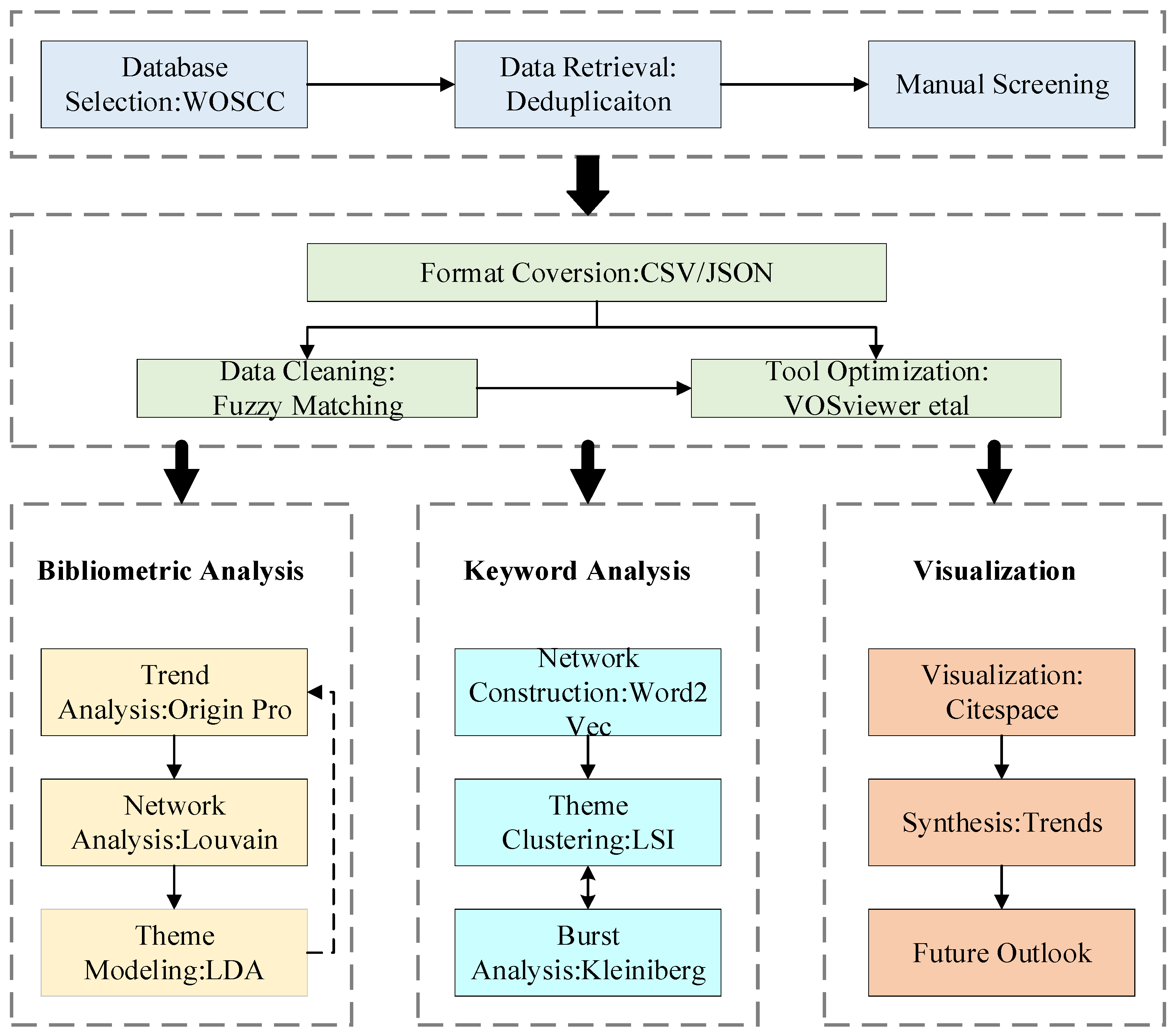
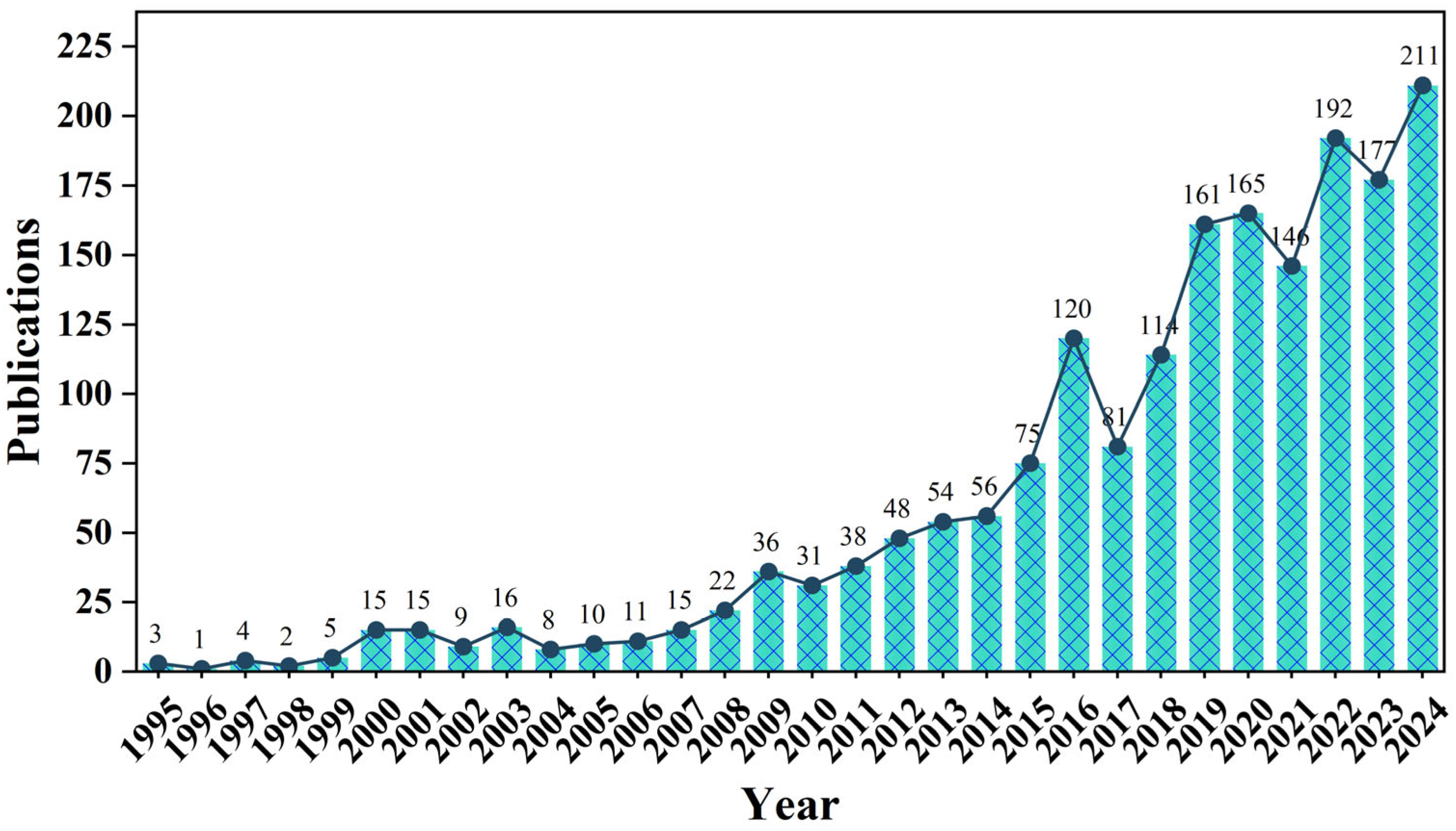
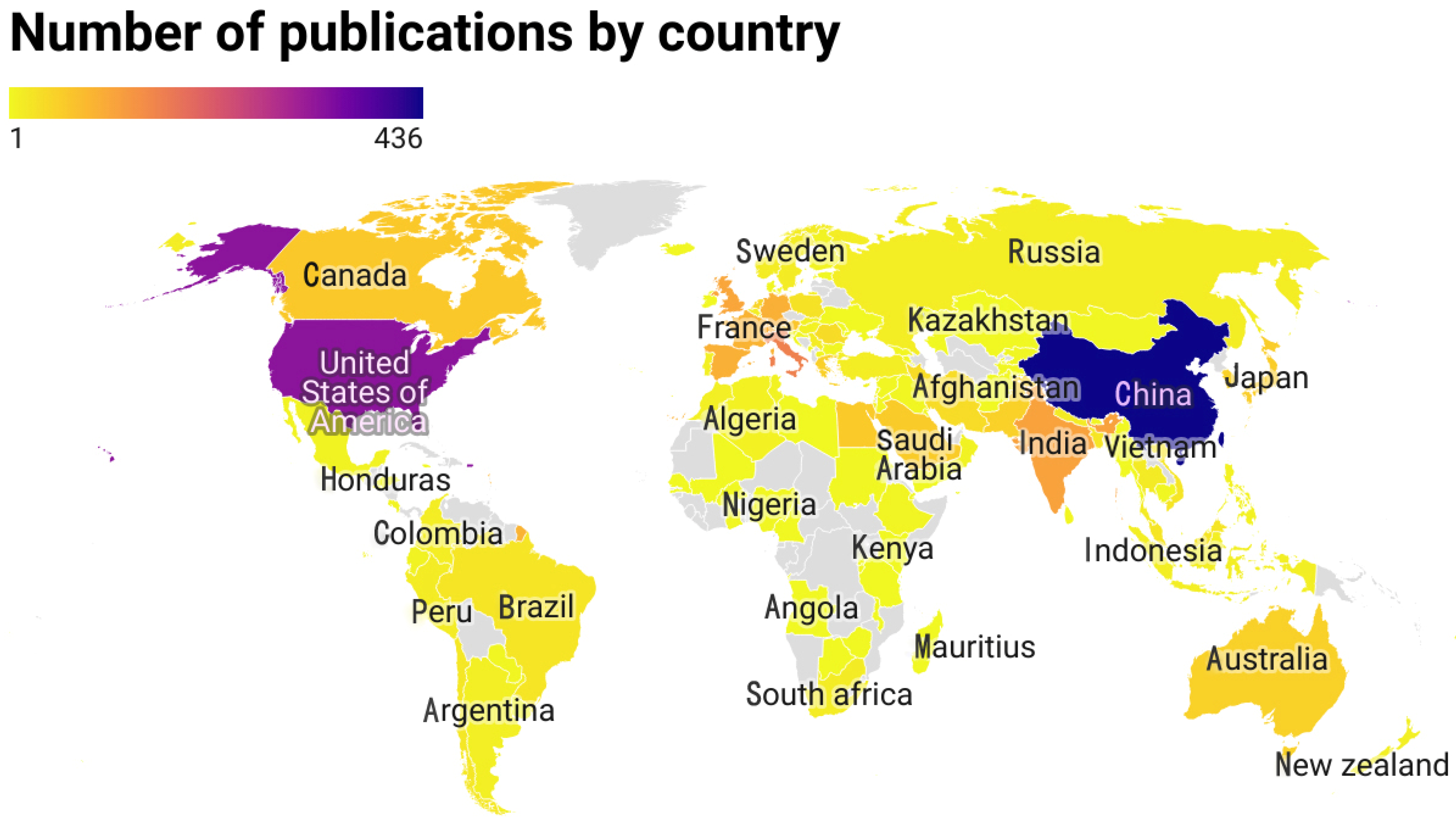
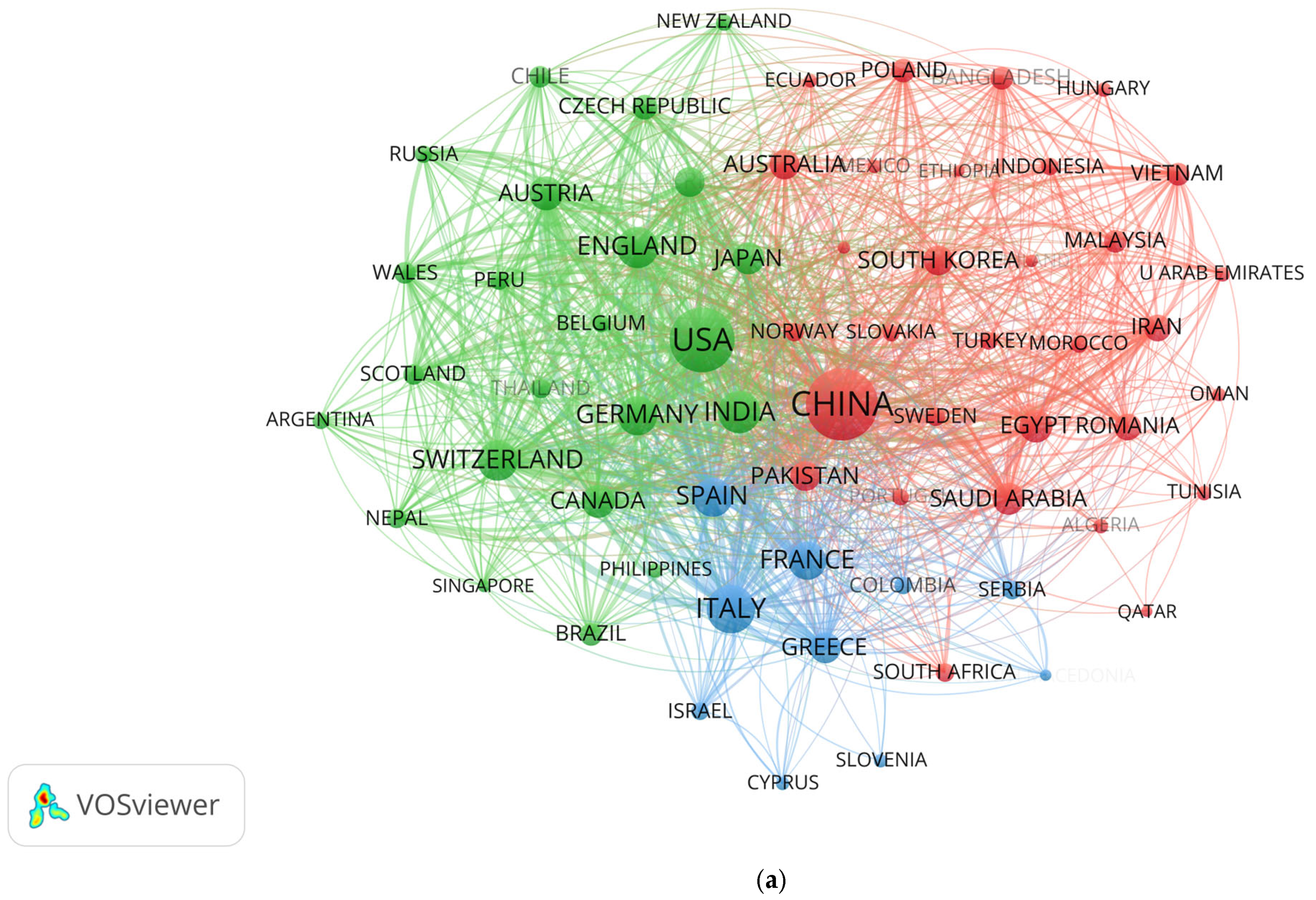
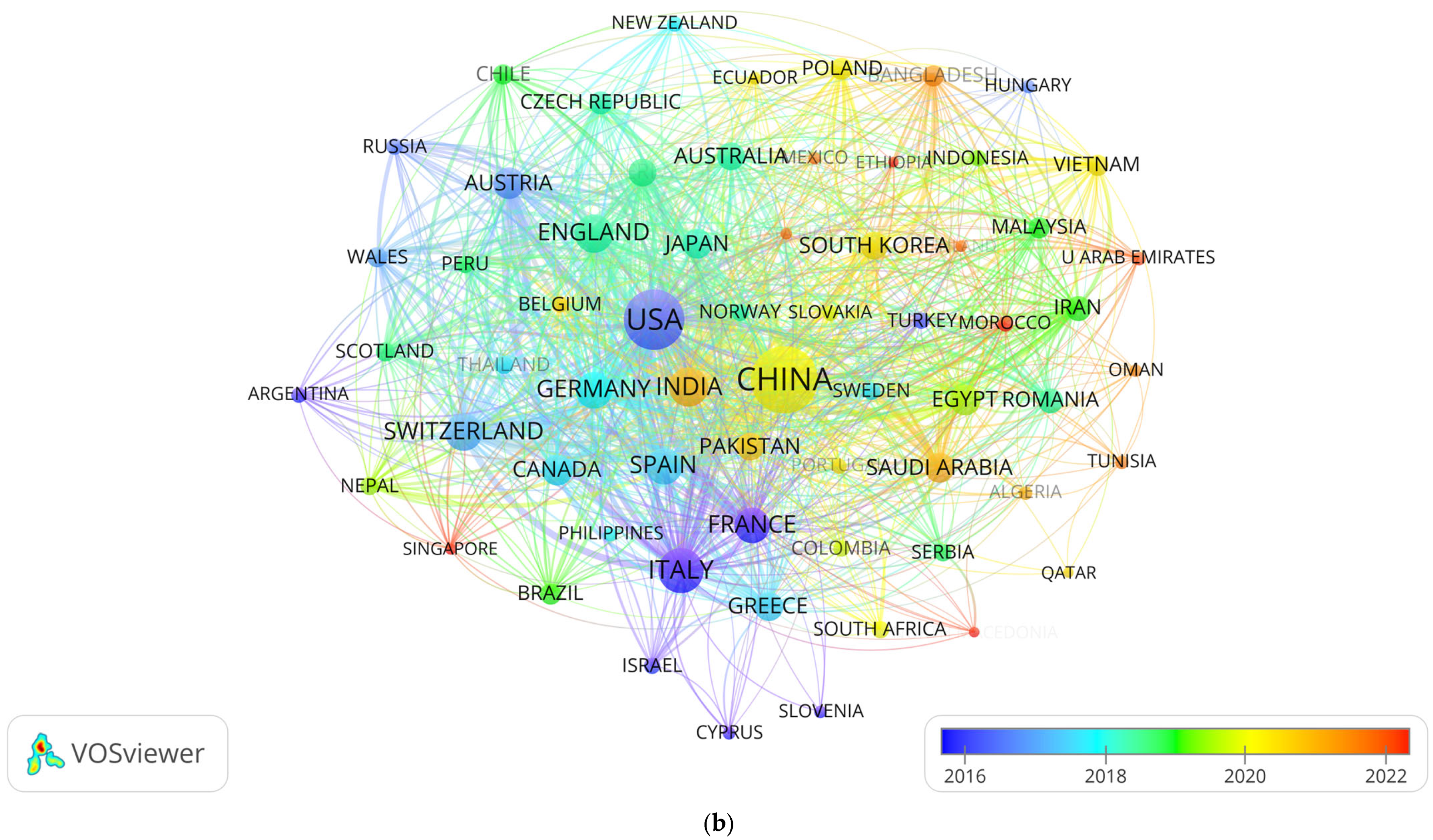
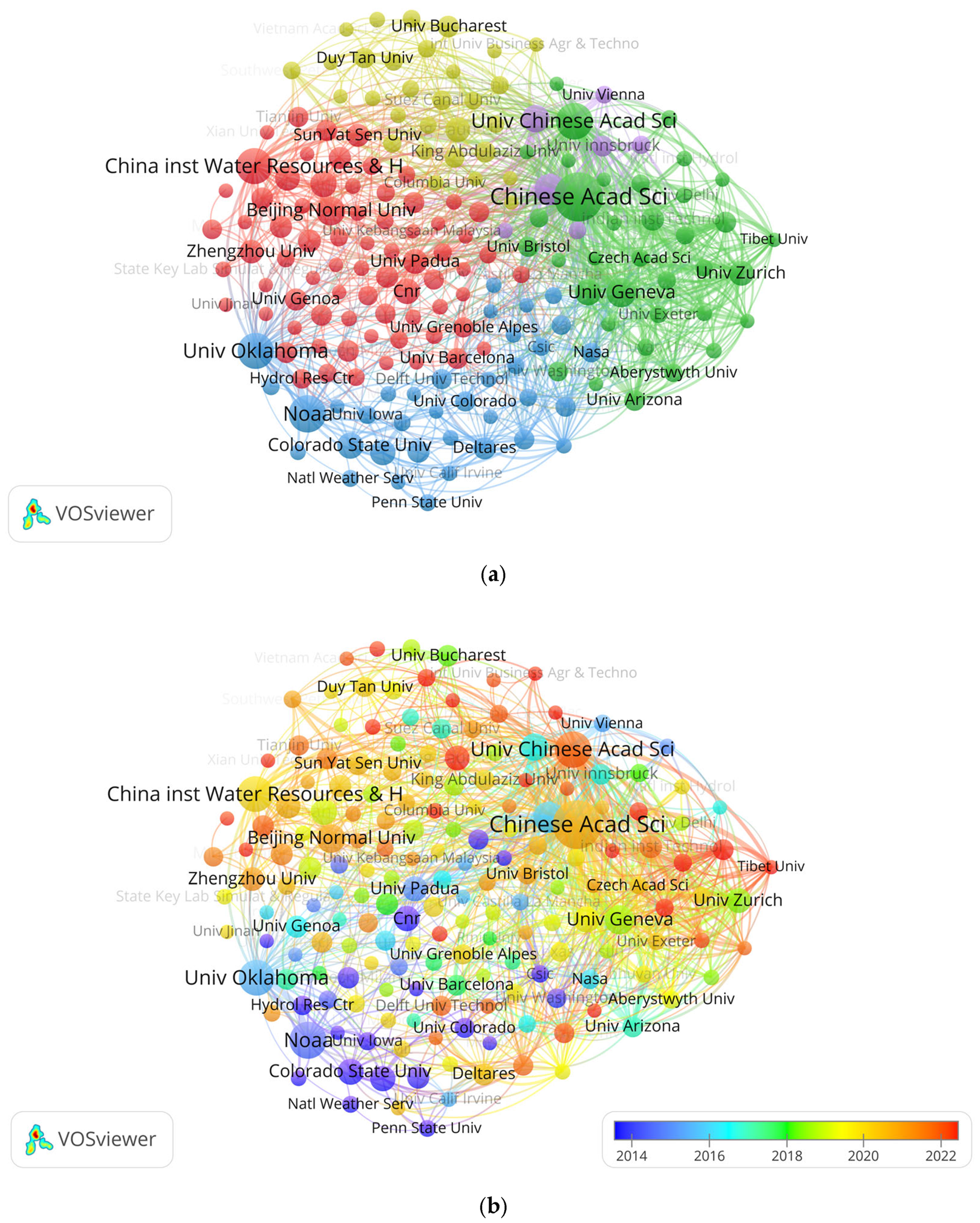
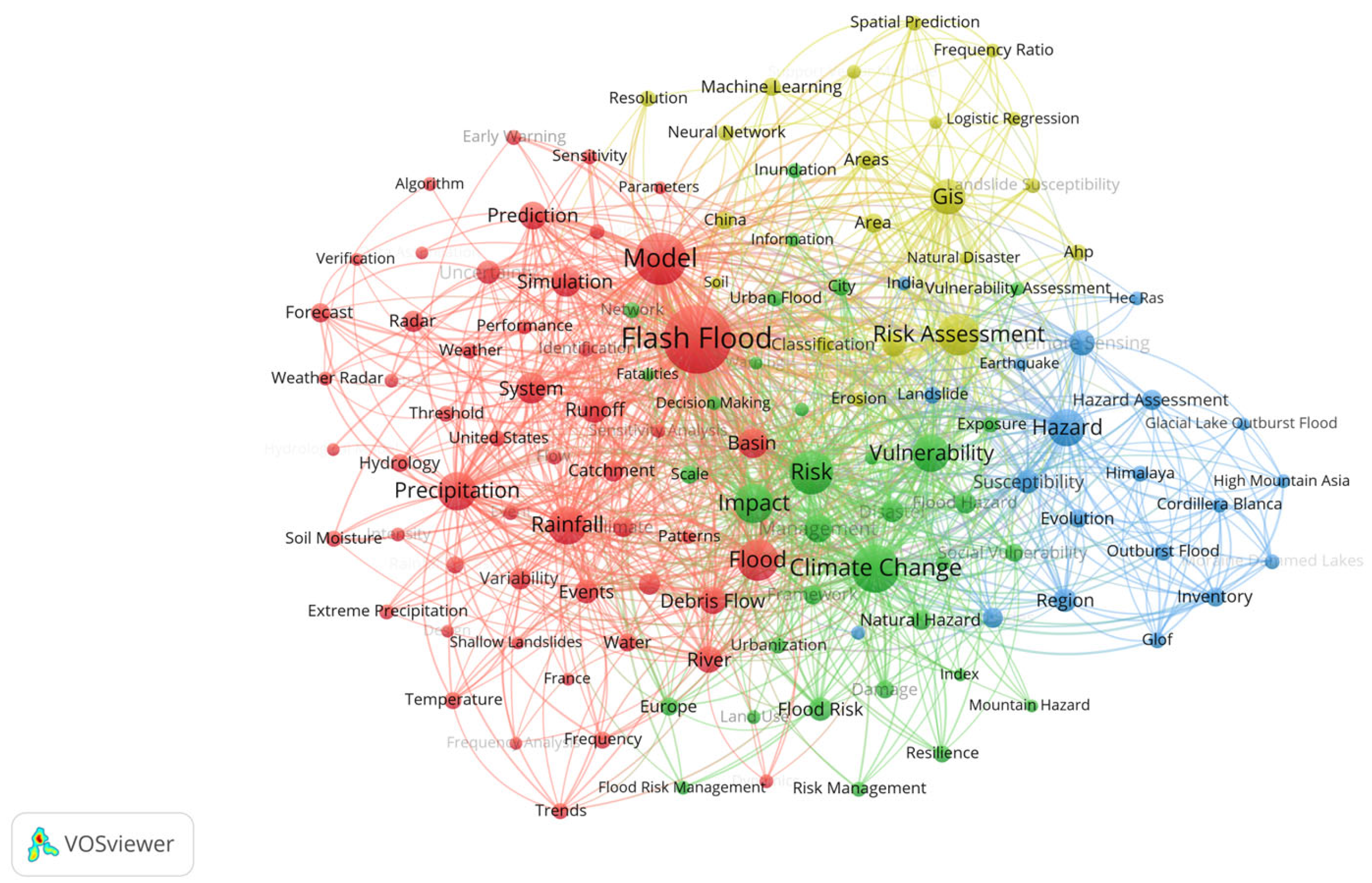

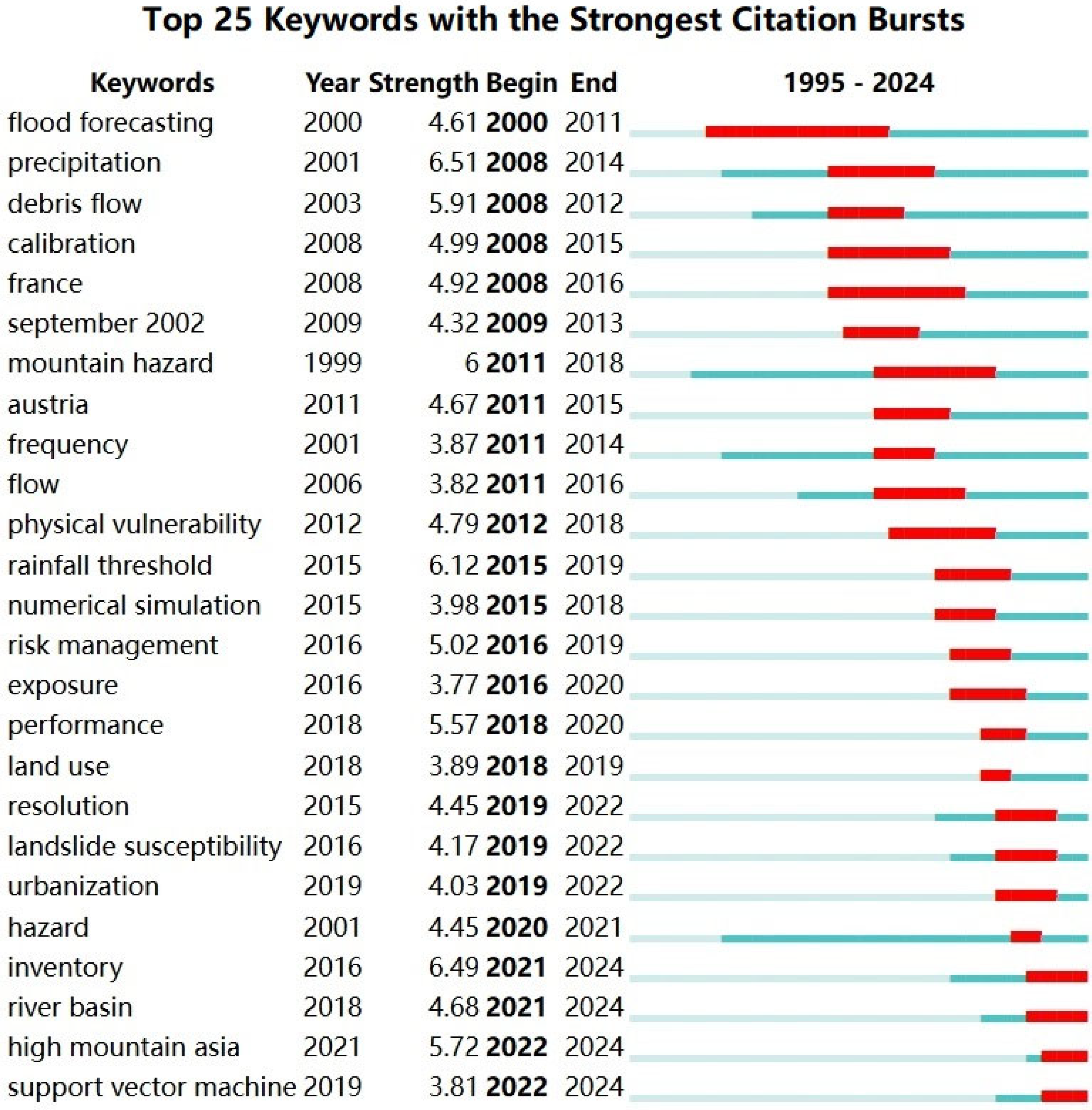

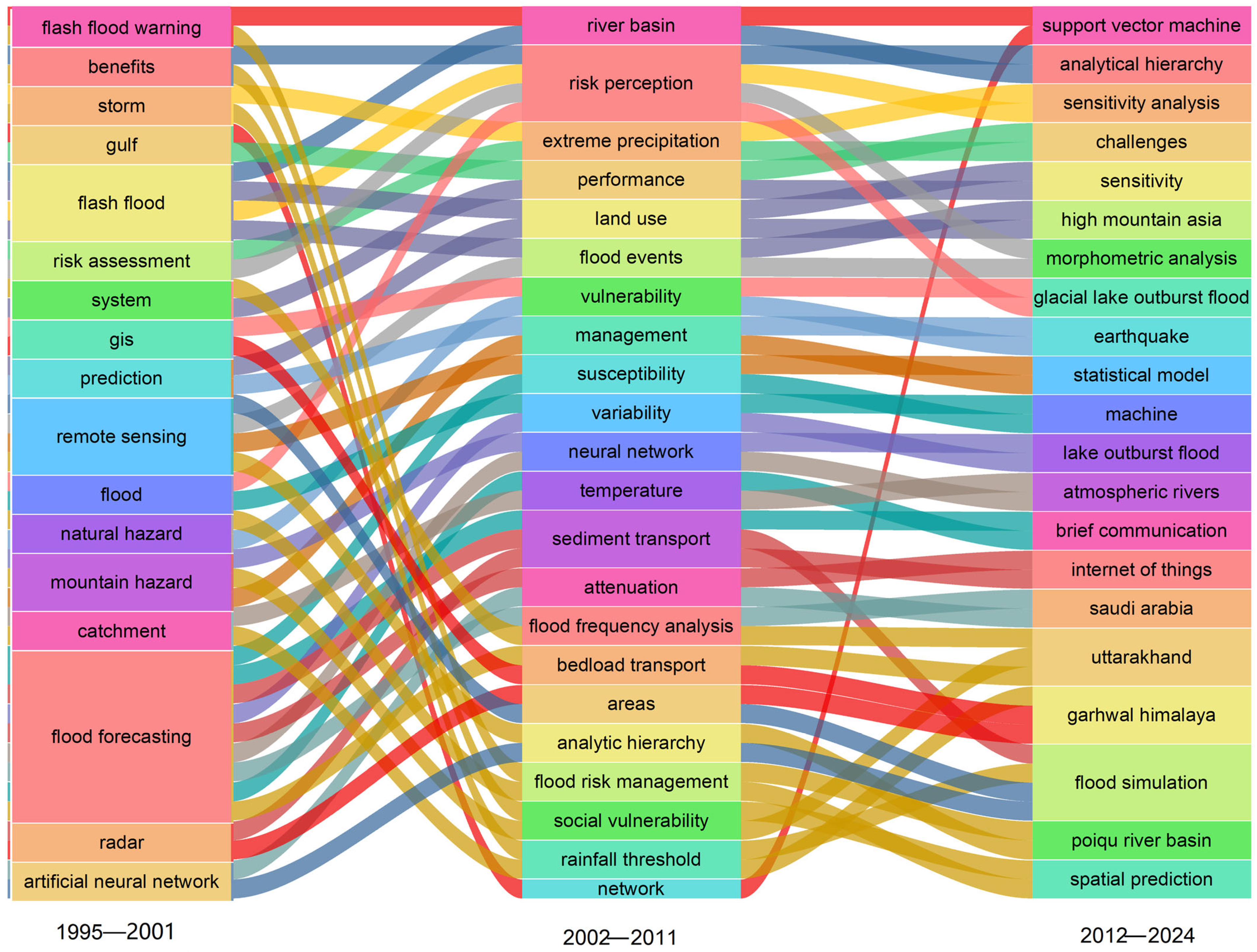
Disclaimer/Publisher’s Note: The statements, opinions and data contained in all publications are solely those of the individual author(s) and contributor(s) and not of MDPI and/or the editor(s). MDPI and/or the editor(s) disclaim responsibility for any injury to people or property resulting from any ideas, methods, instructions or products referred to in the content. |
© 2025 by the authors. Licensee MDPI, Basel, Switzerland. This article is an open access article distributed under the terms and conditions of the Creative Commons Attribution (CC BY) license (https://creativecommons.org/licenses/by/4.0/).
Share and Cite
Li, Q.; Tang, Y.; Wang, S.; Wu, X.; Luan, Y. Mountain Flood Risk: A Bibliometric Exploration Across Three Decades. Water 2025, 17, 1513. https://doi.org/10.3390/w17101513
Li Q, Tang Y, Wang S, Wu X, Luan Y. Mountain Flood Risk: A Bibliometric Exploration Across Three Decades. Water. 2025; 17(10):1513. https://doi.org/10.3390/w17101513
Chicago/Turabian StyleLi, Qian, Yuanbin Tang, Shuai Wang, Xiuguang Wu, and Yong Luan. 2025. "Mountain Flood Risk: A Bibliometric Exploration Across Three Decades" Water 17, no. 10: 1513. https://doi.org/10.3390/w17101513
APA StyleLi, Q., Tang, Y., Wang, S., Wu, X., & Luan, Y. (2025). Mountain Flood Risk: A Bibliometric Exploration Across Three Decades. Water, 17(10), 1513. https://doi.org/10.3390/w17101513





